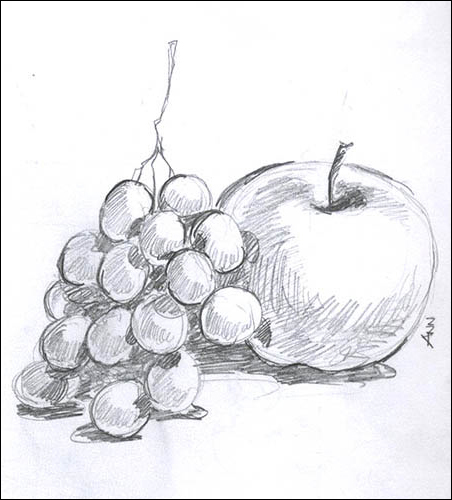
Concise ART-icles
Written and Illustrated by: Ann B.S.
Surest Ways to Improve Your Drawing
Oct 20, 2019
1. Do Figure Drawing
My childhood art mentor Rolly Buenafe, an artist/lecturer of the Planetarium, a comic illustrator in his earlier years, only taught me the shortcut to be better at it.
What the maestro said:
"If you want to be *really* good in illustration (and ART), the only shortcut is to learn FIGURE drawing because it is the hardest subject to draw than anything else! Learn to draw people, then the rest of the objects would be easy. Don't start to be abstract artists. Master the conventional skill first before distorting it because only the masters can destroy the art..."
If a parent is reading this, encourage your artistic child to work hard in drawing the figure. Recommended book for further study:
Figure Drawing for All Its Worth" by Andrew Loomis
2. Draw Everyday
Never sleep without drawing anything, even in pencil. Draw every day! Nothing gets achieved without practice.


Custom Thin Drawing Board for Sketching (If you will buy the idea):
By preference, you can have a custom-made thin plywood drawing board (topped by white Formica or white vinyl wallpaper) at hand. Its purpose is for convenience. You can sit anywhere when you feel like sketching and also take the board anywhere. I find it useful because even in the present I have two (2) sets with me. I even use it when I draw with my Wacom tablet while facing the PC! The size will vary depending on you. I am very convenient with the size: 17" x 14" (43 cm x 36cm), 1/8" to 1/4" thick. You can make yours a bit wider. You can use masking tape or clips to keep your drawing paper in place. I prefer masking tape.

3. Apply the Principle of Perspective
Don't limit yourself to doing 2D-looking drawings. The eyes could see depth (3D). Perspective Drawing is a huge topic in the artistic world. You could look down or look above at an object. This solidity, as it falls into a plane, is what this topic is all about. Draw with a sense of perspective.
Never draw what your mind thinks it can see. Draw exactly HOW you perceive the object sits on a plane. The brain is very tricky when it comes to visualization. It adds information on how we see an object plus the lack of hand coordination. Any layman would draw something else all the time, but an artist would draw the exact form of what she can see at an angle.
I have written about Understanding Basic Perspective in One Seating
for more information.
4. Observe
Observe everything. Differentiate each object from the other. For example, how does a male cat differ from a female cat? They could look the same, but for sure, there is a difference. What makes the person appear aged? What makes an infant younger-looking? What line and contour you need to add to achieve the convincing output? Look at the texture. What makes an angry face more convincing? Research on how things pair if you are into realism. Have you seen an Underwood typewriter?
And if your memory is not as sharp as you think, then #5 (below) will always be the best move!
5. Use References (Picture or Actual Object):
If you have doubts about how an object exactly looks, use reference. They come in a picture or actual objects.
An example for your pure entertainment:
If you do not know how a carabao looks, find pictures for reference. Copy or re-invent from out of the image. A picture may only show the front view or limited angle. Gather enough comparison of subjects based on your requirements. Even if the art theme is outlandish, always use natural references before deviating from it.
As for the carabao on the right, I took this photo during a provincial visit. In one look, what did you observe? The rest are self-explanatory.

On to drawing people:
If you draw various races, use pictures to differentiate one from the other. Common genetic traits vary from one another. The features and characters need heavy references.
Some curiosities to ask yourself:
How do you draw an Asian to appear more Asian? What are the physical traits? If you would draw an action scene, for example, how does the heroine hold the gun? How does the flow from falling water recede? How do you project reflections? Why do the waves get smaller as it gets far? What is an Adam chair? (Oh, the Adam chair reminded me of my college dean.
And so on.
6. Research & Never Stop Reading:
If you are to draw based on a specific timeline, research the culture, manner/style of dressing, transportation, architecture. It is indeed complex. You will realize that all of the data gatherings consume time, let alone the drawing.
If you get assigned to draw scenarios from the Victorian Era, it will include all details like fashion, table setting, sports, vanity, ornament, furniture, everything, including how docile women were! It helps to see the signature attributes. Knowing the back story adds conviction to the execution of art. Inspiration helps as a guide in expressing yourself.
Reading the correct references is everything.
7. Be Conscious of Scale
Use the figure to give your art an element of scale. If possible, add people to your landscape art.
Draw smaller objects when they are at a distance. Use line-weight. The thicker the line means the nearer it is to the viewer. Use lighter shading if the object is very far. The face of a figure looks very detailed when near, while less detailed when far.
Measurement matters. It was my first pitfall as a kid, worst! It got corrected when I took up drafting in college. Having strong knowledge in scale in relation to art is a plus!